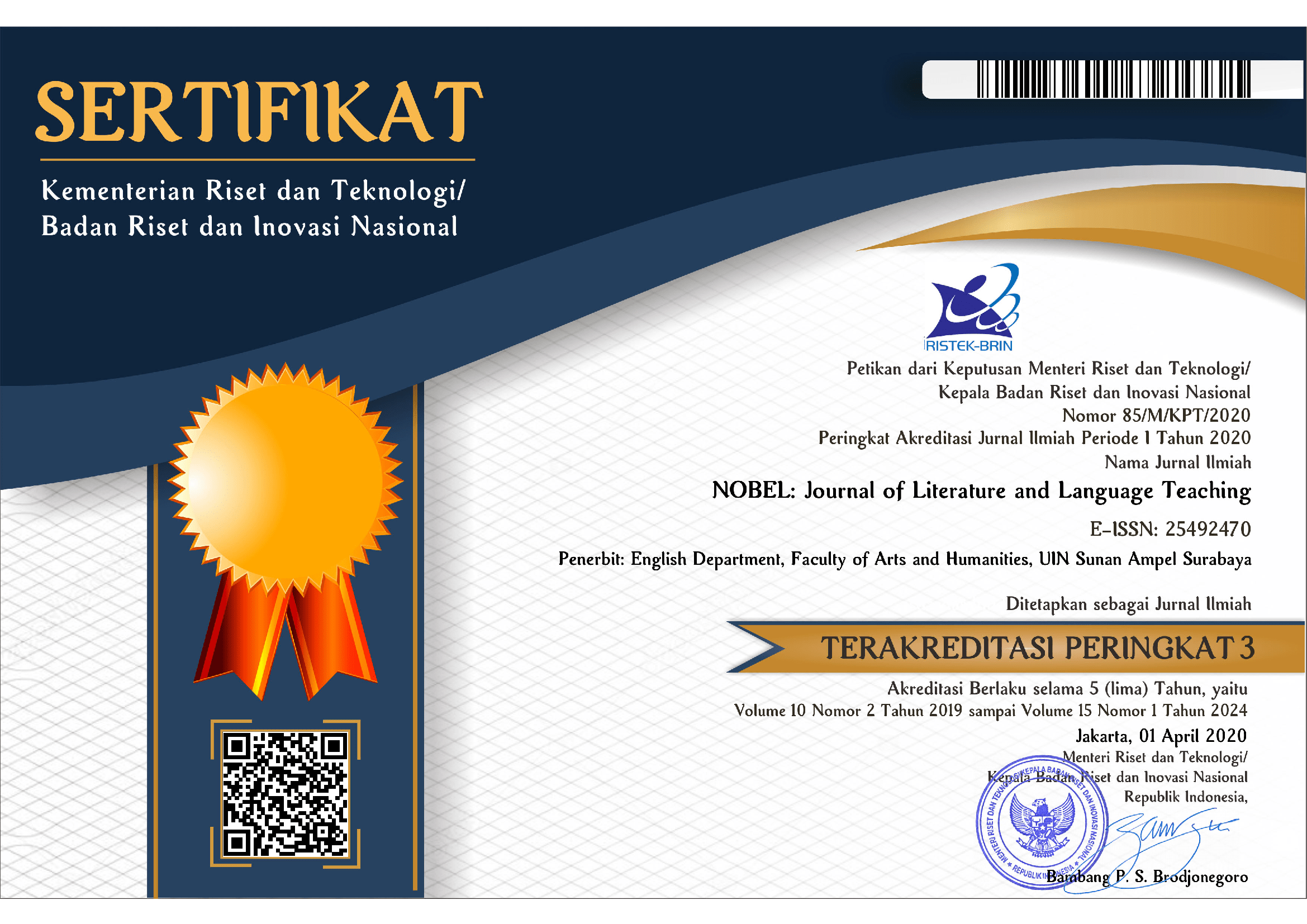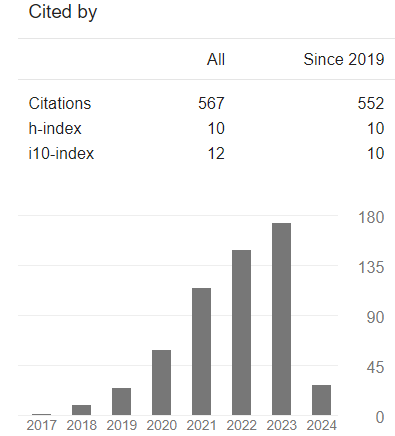Revealing Higher Education Students’ Readiness for Abrupt Online Learning in Indonesia amidst Covid-19
DOI:
https://doi.org/10.15642/NOBEL.2021.12.1.43-59Abstract
COVID 19 pandemic has influenced many sectors, including education. The outbreak hinders teaching and learning activities, which have usually been carried out in a face-to-face meeting. In Higher Education, online learning becomes a crucial need to keep the teaching and learning going on. It has been a sudden shift for students of the English Education Study Program at Tidar University to have online teaching and learning throughout the whole semester. This study explores the students’ readiness for online learning and investigates the aspect that tangles their online learning. A total of 188 students, from first-year students to senior students, participated in this study. The Online Learning Readiness Scale (OLRS) and interview were used to appraise the students’ readiness for online learning. Internet self-efficacy, self-directed learning, learner control, motivation for learning, and online communication self-efficacy were assessed. The result of the scale revealed that the students were at a moderate level of online learning readiness. The highest contribution to their readiness was from their motivation for online learning. Moreover, surprisingly, the biggest challenge was the learner control. They were mainly distracted by other online activities during their online learning. Also, conducting online learning needs to involve various technologies and more structured activities to enhance their readiness.
Downloads
References
Agung, A. S. N., Surtikanti, M. W., & Quinones, C. A. (2020). Students’ perception of online learning during COVID-19 pandemic: A case study on the English students of STKIP Pamane Talino. Journal of Social Sciences and Humanities, 10(2), 225–235. DOI: 10.31940/soshum.v10i2.1316
Al-Said, K. M. (2015). Students’ perceptions of Edmodo and mobile learning and their real barriers towards them. TOJET: The Turkish Online Journal of Educational Technology, 14(2), 167-180. https://files.eric.ed.gov/fulltext/EJ1057371.pdf
Ali, I. E. H. (2010). Measuring Students e-readiness for e-learning at Egyptian faculties of tourism and hotels. The 6th International Scientific Conference on E-Learning and Software for Education, Bucharest, 2010(1), 145–154. https://www.ceeol.com/search/article-detail?id=129078
Aljawarneh, S. A. (2020). Reviewing and exploring innovative ubiquitous learning tools in higher education. Journal of Computing in Higher Education, 32(1), 57–73. DOI: 10.1007/s12528-019-09207-0
Alomyan, H. (2017). A conceptual framework for web-based learning design. Proceedings of the International Conference on E-Learning, EL 2017 - Part of the Multi Conference on Computer Science and Information Systems 2017, 191–195. https://files.eric.ed.gov/fulltext/ED579370.pdf
Azis, Y. M., Suharyati, H., & Susanti, S. (2019). Student’s experience of e-learning, learning process and perceived learning outcomes in economic math course. JHSS (Journal of Humanities and Social Studies), 03(02), 67–70. DOI: 10.33751/jhss.v3i2.1458
Bozkurt, A., Akgun-Ozbek, E., Yilmazel, S., Erdogdu, E., Ucar, H., Guler, E., Sezgin, S., Karadeniz, A., Sen-Ersoy, N., Goksel-Canbek, N., Dincer, G. D., Ari, S., & Aydin, C. H. (2015). Trends in distance education research: A content analysis of journals 2009-2013. International Review of Research in Open and Distance Learning, 16(1), 330–363. DOI: 10.19173/irrodl.v16i1.1953
Buselic, M. (2012). Distance Learning – concepts and contributions. Oeconomica Jadertina, 2(1), 23–34. https://hrcak.srce.hr/83575
Chavez, S., Long, B., Koyfman, A., & Liang, S. Y. (2020). Coronavirus Disease (COVID-19): A primer for emergency physicians. American Journal of Emergency Medicine, 3(2020), 1-10. DOI: 10.1016/j.ajem.2020.03.036
Chung, E., Noor, N. M., & Mathew, V. N. (2020). Are you ready? an assessment of online learning readiness among university students. International Journal of Academic Research in Business and Social Sciences, 9(1), 301–317. DOI: 10.6007/IJARPED/v9-i1/7128
Chung, E., Subramaniam, G., & Dass, L. C. (2020). Online learning readiness among university students in Malaysia amidst Covid-19. Asian Journal of University Education, 16(2), 46-58. DOI: 10.24191/ajue.v16i2.10294
Churiyah, M., Sholikhan, S., Filianti, F., & Sakdiyyah, D. A. (2020). Indonesia education readiness conducting distance learning in Covid-19 pandemic situation. International Journal of Multicultural and Multireligious Understanding, 7(6), 491-507. DOI: 10.18415/ijmmu.v7i6.1833
Doe, R., Castillo, M. S., & Musyoka, M. M. (2017). Assessing online readiness of students. Online Journal of Distance Learning Administration, 20(1). 27-37. https://www.westga.edu/~distance/ojdla/spring201/doe_castillo_musyoka201.html
Dray, B. J., Lowenthal, P. R., Miszkiewicz, M. J., Ruiz-Primo, M. A., & Marczynski, K. (2011). Developing an instrument to assess student readiness for online learning: A validation study. Distance Education, 32(1), 29–47. DOI: 10.1080/01587919.2011.565496
Eko, A., Atmojo, P., & Nugroho, A. (2020). EFL classes must go online! Teaching activities and challenges during COVID-19 pandemic in Indonesia. Register Journal, 13(1), 49–76. DOI: 10.18326/rgt.v13i1.49-76
Ermakova, Y. V., Demyanenko, N. V., Kurovskii, V. N., Tsepilova, A. V., & Kadochnikova, S. A. (2017). The concept of mobile learning of university students when studying foreign language. Asian EFL Journal, 2017(97), 108–122. https://asian-efl-journal.com/wp-content/uploads/AEJ-TA-97-January-2017-1.pdf#page=108
Fansury, A. H., Januarty, R., Rahman, A. W., & Syawal. (2020). Digital content for millennial generations: Teaching the English foreign language learner on Covid-19 pandemic. Journal of Southwest Jiaotong University, 55(3). DOI: 10.35741/issn.0258-2724.55.3.40
Griffiths, B. (2016). A faculty’s approach to distance learning standardization. Teaching and Learning in Nursing, 11(4), 157–162. DOI: 10.1016/j.teln.2016.04.004
Hall, S., & Villareal, D. (2015). The hybrid advantage: Graduate student perspectives of hybrid education courses. International Journal of Teaching and Learning in Higher Education, 27(1), 69–80. https://files.eric.ed.gov/fulltext/EJ1069791.pdf
Händel, M., Stephan, M., Gläser-Zikuda, M., Kopp, B., Bedenlier, S., & Ziegler, A. (2020). Digital readiness and its effects on higher education student socio-emotional experiences in the context of COVID-19 pandemic. Journal of Research on Technology, 2020(July), 1-29. DOI: 10.31234/OSF.IO/B9PG7
Hasani, L. M., Adnan, H. R., Sensuse, D. I., Kautsarina, K., & Randy Suryono, R. R. (2020). Factors Affecting Student’s Perceived Readiness on Abrupt Distance Learning Adoption: Indonesian Higher-Education Perspectives. 2020 3rd International Conference on Computer and Informatics Engineering (IC2IE), 286–292. DOI: 10.13140/RG.2.2.22908.16008
Hung, M. L., Chou, C., Chen, C. H., & Own, Z. Y. (2010). Learner readiness for online learning: Scale development and student perceptions. Computers and Education, 55(3), 1080–1090. DOI: 10.1016/j.compedu.2010.05.004
Hunt, A.M. (2015). Blended online learning in initial teacher education: A Professional Inquiry on preservice teachers’ inquiry projects. Journal of Open, Flexible, and Distance Learning, 19(2), 48-60. https://www.learntechlib.org/p/161942/
Joksimovi?, S., Gaševi?, D., Kovanovi?, V., Riecke, B. E., & Hatala, M. (2015). Social presence in online discussions as a process predictor of academic performance. Journal of Computer Assisted Learning, 31(6), 638–654. DOI: 10.1111/jcal.12107
Linjawi, A. I., & Alfadda, L. S. (2018). Students’ perception, attitudes, and readiness toward online learning in dental education in Saudi Arabia: a cohort study. Advances in Medical Education and Practice, 9, 855–863. DOI: 10.2147/amep.s175395
Mohalik, R., & Sahoo, S. (2020). E-readiness and perception of student teachers’ towards online learning in the midst of COVID-19 pandemic. SSRN Electronic Journal, 2020(8). DOI: 10.2139/ssrn.3666914
Munshi, J. (2014). A method for constructing Likert Scales. SSRN Electronic Journal, 2014(4). DOI: 10.2139/ssrn.2419366
Neupane, H. C., Sharma, K., & Joshi, A. (2020). Readiness for the online classes during COVID-19 pandemic among students of Chitwan Medical College. Journal of Nepal Health Research Council, 18(2), 316–319. DOI: 10.33314/jnhrc.v18i2.2725
Rasmitadila, Aliyyah, R. R., Rachmadtullah, R., Samsudin, A., Syaodih, E., Nurtanto, M., & Tambunan, A. R. S. (2020). The perceptions of primary school teachers of online learning during the covid-19 pandemic period: A case study in Indonesia. Journal of Ethnic and Cultural Studies, 7(2), 90–109. DOI: 10.29333/ejecs/388
Rasouli, A., Rahbania, Z., Attaran, M., & Gaduate, ]. (2016). Students’ readiness for e-learning application in higher education. Malaysian Online Journal of Educational Technology, 4(3), 51-64. https://files.eric.ed.gov/fulltext/EJ1106478.pdf
Smith, B.G. E-learning technologies: A comparative study of adult learners enrolled on blended and online campuses engaging in a virtual classroom. Doctor of Philosophy thesis, Capella University. Retrieved April 29, 2021, from https://www.learntechlib.org/p/115478/.
Smith, C., Hoderi, M., & Mcdermott, W. (2019). A preliminary study of students’ perception and learning from different delivery methods. Academy of Educational Leadership Journal, 23(2), 1-8. https://www.abacademies.org/articles/A-preliminary-study-of-students-perception-and-learning-from-different-delivery-methods-1528-2643-23-2-130.pdf
Triandis, H. C., & Hofstede, G. (1993). Cultures and Organizations: Software of the Mind. Administrative Science Quarterly, 38(1), 132-134. DOI: 10.2307/2393257
Vance, T. C., Merati, N., Yang, C. P., & Yuan, M. (Eds.). (2016). Cloud computing in ocean and atmospheric sciences. London: Academic Press.
Wan Husin, W. N. F., Arsad, N. M., Othman, O., Halim, L., Rasul, M.S., Osman, K., & Iksan, Z. (2016). Fostering students’ 21st century skills through Project Oriented Problem Based Learning (POPBL) in integrated STEM education program. Asia-Pacific Forum on Science Learning and Teaching, 17(1), 60-77. https://www.eduhk.hk/apfslt/download/v17_issue1_files/fadzilah.pdf
Weidlich, J., & Bastiaens, T. J. (2018). Technology matters - The impact of transactional distance on satisfaction in online distance learning. International Review of Research in Open and Distance Learning, 19(3), 222–242. DOI: 10.19173/irrodl.v19i3.3417
Downloads
Published
How to Cite
Issue
Section
License
Copyright (c) 2021 NOBEL: Journal of Literature and Language Teaching

This work is licensed under a Creative Commons Attribution 4.0 International License.







